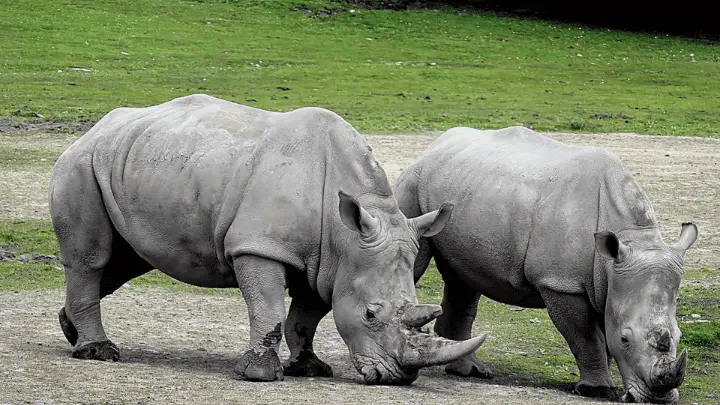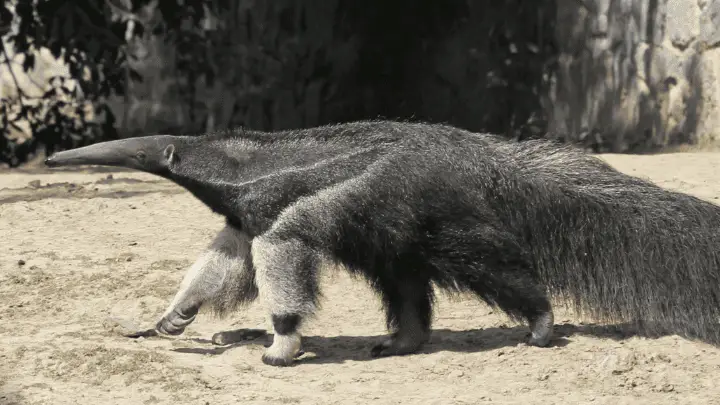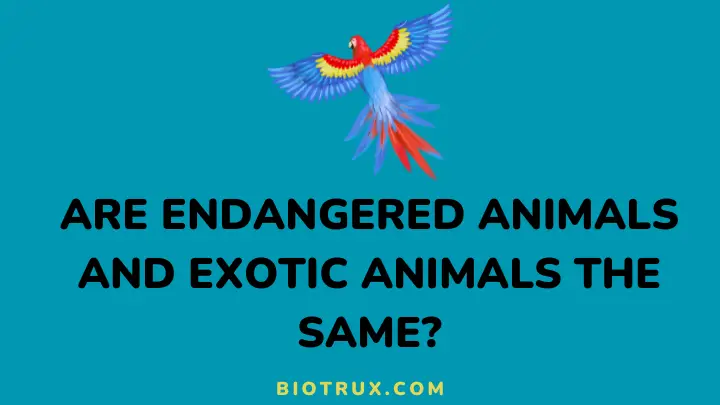Welcome to another interesting topic in the fascinating world of animals! In this article, I will explore the intriguing question of whether endangered animals and exotic animals are the same.
Although both types of animals are often associated with conservation and protection efforts, there are significant differences between them that are worth exploring. Do you wonder why some animals are considered exotic while others are endangered?
Or perhaps you’re curious about these animals’ different causes and sources. No matter what your level of knowledge about animals is, by the end of this article, you’ll better understand what makes these animals unique and why protecting them for future generations is essential.
So, let’s dive right in!
Understanding Endangered Animals

Definition and characteristics of endangered animals
Endangered animals are species that face a high risk of extinction in the near future. These creatures exhibit specific characteristics that make them vulnerable:
1. Small population size: Endangered species have dwindling populations, often reduced to a critical number. Additionally, their limited genetic diversity makes them susceptible to diseases and environmental changes.
2. Restricted habitat range: These animals inhabit specific ecosystems or regions that are threatened by human activities or natural disasters. Their inability to adapt to new environments exacerbates their endangerment.
3. Specialized ecological niches: Endangered species often occupy unique niches within ecosystems. Their disappearance disrupts the environmental balance and affects other species that rely on them.
4. Low reproductive rates: Many endangered animals reproduce slowly, with long gestation periods or infrequent breeding cycles. This hinders population recovery.
5. Human dependence or conflict: Some species face endangerment due to direct human exploitation (such as hunting or poaching) or indirect effects (habitat destruction, pollution, and climate change).
Causes of endangerment
Several factors contribute to the endangerment of animal species:
1. Habitat Loss: The destruction of natural habitats due to deforestation, urbanization, and agriculture reduces available space for wildlife. Furthermore, fragmented habitats isolate populations, making it harder for animals to find mates and resources.
2. Pollution: Pollution from industrial activities, chemicals, and plastics harms both terrestrial and aquatic ecosystems. Contaminated water, air, and soil affect animal health and reproductive success.
3. Climate Change: Rising temperatures, altered precipitation patterns, and extreme weather events disrupt ecosystems. Species adapted to specific climates struggle to survive in changing conditions.
4. Overexploitation: Hunting, fishing, and capturing animals for trade or traditional practices threaten their survival. Overharvesting reduces population size and disrupts natural balance.
5. Invasive Species: Non-native species introduced intentionally or accidentally can outcompete native animals for resources. In addition, they often lack natural predators, leading to population declines.
6. Disease: Pathogens and diseases can devastate animal populations. Endangered species with small populations are particularly vulnerable.
7. Lack of legal protection: Inadequate conservation laws and enforcement allow illegal activities like poaching and habitat destruction to persist.
8. Human-wildlife conflict: As human populations expand, conflicts arise between people and animals. Retaliatory killings occur when animals damage crops or threaten human safety.
9. Genetic Issues: Reduced genetic diversity due to small populations increases susceptibility to diseases and reduces adaptability.
10. Natural disasters: Events like earthquakes, volcanic eruptions, and tsunamis can wipe out entire populations.
Understanding these causes empowers us to take action. Conservation efforts, habitat restoration, and sustainable practices are essential to protect endangered animals and preserve biodiversity.
Examining Exotic Animals

Defining exotic animals and their unique traits
Exotic animals are animals that come from different parts of the world. They have unique characteristics that set them apart from the animals that are typically found in a particular area.
Exotic animals are fascinating creatures that stand out due to their rarity, unique appearance, and distinct behavior. Here’s what sets them apart:
- Not domesticated: Exotic animals are not domesticated and thrive in the wild, far from our everyday lives. Their uniqueness lies in their untamed nature.
- Unusual and rare: These creatures are more than your typical dog or cat. They encompass a wide array of species, from colorful reptiles to elusive primates.
- Diverse classes: Exotic animals span various classes:
- Exotic mammals: Warm-blooded, fur-covered, and live-bearing, they include the serval (a large cat), the pygmy goat, and the axolotl (an amphibian).
- Exotic birds: Vibrant parrots, toucans, and other feathered wonders.
- Exotic reptiles: Think iguanas, chameleons, and snakes.
- Exotic fish: From the mesmerizing discus to other aquatic marvels.
Sources of exotic animals
- Legal trade and captive breeding:
- Some exotic pets are bred in captivity to protect them from being poached from the wild. This is done to help preserve wild animal populations and prevent further endangerment. Proper legal documentation allows for the export of these captive-bred animals.
- Conservationists endorse this approach, but it’s essential to ensure ethical practices.
- Illegal trafficking:
- Unfortunately, countless animals are illegally captured from the wild. These creatures are smuggled, mislabeled, and sold globally.
Impact of the exotic pet trade
- Devastating animal populations: Rampant poaching for the exotic pet trade has decimated species like Madagascar’s radiated tortoises and the African gray parrots known for their vocal abilities. Many animals suffer during capture and transport, leading to distress and compromised well-being.
- Ecosystem disruption: The exotic pet trade disrupts ecosystems. Each species plays a vital role: monkeys transport seeds, birds pollinate forests, and sharks maintain coral reef health. Depletion of wild populations affects ecological balance.
Are Endangered Animals and Exotic Animals Mutually Exclusive?
Sometimes, animals can be both exotic and endangered. Exotic animals are those that are not typically found in a particular area, while endangered animals are those that are facing a high risk of extinction.
However, there can be situations where these categories overlap, meaning that certain exotic animals may also be endangered in their natural habitats. This can happen because of various human activities such as poaching, deforestation, and habitat destruction.
As a result, the classification of animals as exotic or endangered is not always clear-cut, and they can sometimes fall into both categories.
FAQs
What distinguishes endangered animals from exotic animals?
Endangered animals face the risk of extinction due to factors like habitat loss, while exotic animals are species not native to a particular region.
How do conservation efforts differ for endangered and exotic species?
Conservation efforts for endangered species focus on preserving habitats and combating threats like poaching. In contrast, efforts for exotic species involve regulating the pet trade and preventing ecological disruptions.
Are all exotic animals endangered?
Not all exotic animals are endangered. While some may face threats in their native habitats, others thrive in captivity or non-native environments.
What role does human activity play in the endangerment of both exotic and endangered species?
Human activity, such as habitat destruction, pollution, and illegal wildlife trade, significantly contributes to the endangerment of both exotic and endangered species.
Can exotic animals be reintroduced into their native habitats for conservation purposes?
In some cases, exotic animals can be reintroduced into their native habitats as part of conservation efforts. However, careful consideration of ecological impact and feasibility is essential.
What are some common misconceptions surrounding endangered and exotic animals?
Common misconceptions include conflating the terms “endangered” and “exotic,” assuming all exotic animals are dangerous, and overlooking the ecological importance of both endangered and exotic species.
Wrapping Up: Are Endangered Animals and Exotic Animals the Same?
In wrapping up, it’s evident that while endangered animals and exotic animals share certain similarities, they are distinct classifications within the realm of wildlife conservation. Endangered species face the imminent threat of extinction, often due to human-induced factors like habitat destruction and poaching.
On the other hand, exotic animals are species that are not naturally found in a particular place and are often interesting to people because they have unique traits. It’s important to understand the differences between these two types of animals so that we can protect them better.
By protecting endangered and exotic animals, we can help keep our planet full of diverse and interesting wildlife for future generations to enjoy.
You can also find out if all endangered animals should be kept in Zoos.
Thanks for reading.

